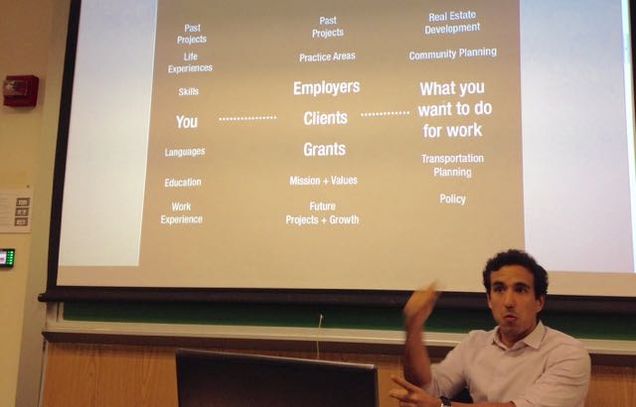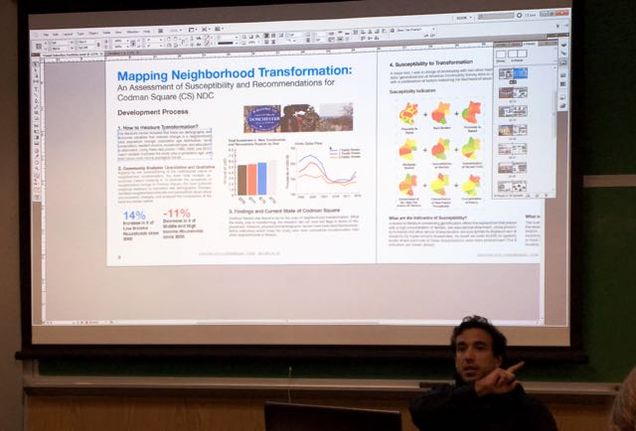To get ahead, #BUCPUA students go visual
As #BUCPUA students complete their Fall 2016 course projects, they might stop to assess how these courses have immediately enhanced their professional standing. Many #BUCPUA students are mid-career professionals who juggle the demands of work, school and family. Alumnus Davis Valecillos (MET’14) knows this stress far too well, but he aggressively urges students to start preparing their career portfolios now. At the #BUCPUA Portfolios for Planners Workshop, students learned how portfolios should visually inform employers of your background, skills, and project experiences. Effectively, a solid portfolio can be the difference between a call back and a rejection letter.

On October 28, Valecillos spent a cold, rainy Friday night with a dedicated group of #BUCPUA students. Together, they explored the preparation required to demonstrate character traits and projects through a visual portfolio. What is a portfolio? A portfolio is a collection of professional work, including course projects, that demonstrates capacity building in the various realms of city planning and urban affairs. Portfolios can be created using InDesign or even PowerPoint, and sometimes it is necessary to professionally print and bind your portfolio through a company such as FedEx.
When showing your portfolio to potential employers, you can “walk them through who you are in a visually appealing, memorable way,” Valecillos explained. To begin, students must understand the portfolio “thought process”. Preparation questions include: What do you want to do? Who can pay you for it (company, client, grant)? What skills do you need? What coursework and projects can you highlight in your portfolio that will reflect all of this?

In the #BUCPUA Program, students take a variety of project-based courses that provide the very skill sets emphasized in portfolios. Courses such as UA 654 Geographic Information Systems for Planners, UA 613 Designing Urban Spaces, US 702 Urban Analytical Methods, and UA 805 Boston Urban Symposium integrate opportunities to develop projects suitable for a planner’s portfolio.
Valecillos, who holds a degree in civil engineering, has masterfully transitioned into the planning field since earning his Master of City Planning degree in 2014. After suffering job rejection, Valecillos’s renewed motivation translated into hard work. He woke early on Saturday mornings, learning the nuances of InDesign and Photoshop. After scouring magazines and professional reports, he began to quickly identify the conceptual frameworks underlying layout design choices. Although his first portfolio was not the best, he continuously refined it until he landed the perfect job. Now, he is a real estate professional with the North Shore Community Development Corporation and also works as a private consultant.
A casual speaker, Valecillos engaged freely with the students. Before providing instruction, Vallecillos had the students describe their biggest worries or challenges with portfolios, and several students said they were not even sure where to begin. Peter Kimball (MET ’18) had no idea where to start with his portfolio, but knew he needed one for job applications and interviews. Kimball started graduate school immediately after earning his undergraduate degree, and he “wanted to put together a professional portfolio with the experience I have.”
Claribel Santiago (MET ’16) said, “I came because it’s another layer of learning that I’m going to have to have in the real world. I want to learn from the presenter, learn from the audience, and I want to learn new ideas to build my confidence. Developing a portfolio boosts my confidence because it is a great way to express myself and my experiences”
Thinking about a portfolio early on is a good idea, said Valecillos. “The most important aspect of a portfolio is keeping the audience in mind. City planners have to present a series of projects that will captivate people who are unfamiliar your work. “If your mom picks it up, will she enjoy it?” asked Valecillos.
The key elements of a portfolio include color and text, formatting, general content, and layout. Valecillos walked students through each element, giving nitty-gritty details and advice. For example, by researching and using the same the color palette of your prospective company, your portfolio will instantly make a positive impression during your interview. He also gave advice on headings, organization, and even paper size.
Projects that comprise a portfolio can be re-arranged and tailored for different interviews. Valecillos recommends keeping each project around four pages, and he provided great example portfolios from issuu.com. Although the students in attendance shared a wide range of career goals, the portfolio advice and organizational templates offered can help advance their career objectives by bringing them one step closer to their dream job.
– Ines Boussebaa (CAS’17) and Courtney Thraen (MET ’17)